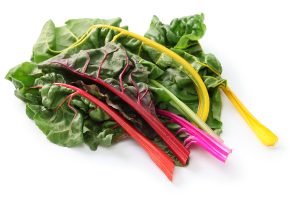In good news for veggies that get little of the limelight, watercress, chinese cabbage and chard tops the list of foods that will give you the most nutrients per bite, suggests a new study. And surprisingly, you’ll find some of the most talked about plant foods in health – such as blueberries – didn’t even make the list.

Chard, ranking #3 on the “powerhouse” list
The study, published in Preventing Chronic Disease, sought to rank how 47 fruits and vegetables stack up as nutrient “powerhouses.” Eating more of these fruits and veggies, notes the study, is one approach linked to reduced risk of chronic diseases, which includes cancer.
“This is a great opportunity to learn about some fruits and vegetables we’re not as familiar with, but for cancer prevention and overall health — ALL fruits and vegetables are powerhouses,” says AICR Associate Director of Nutrition Programs Alice Bender, MS, RDN. “AICR research — and the government guidelines — say what’s most important when it comes to eating fruits and vegetables: eat more, eat a variety.”
For the study, author Jennifer Di Noia, PhD, LCSW, Associate Professor of Sociology at William Paterson University, identified the powerhouses foods based on 17 nutrients, all vital for good health. The nutrients she looked at included vitamins, minerals, protein and fiber. Because there are no clear measures of many phytochemicals, the study did not include phytochemical content when ranking.
Each fruit and vegetable is packed with hundreds of phytochemicals, many that show cancer-fighting properties in lab studies.
First, for the food to even qualify as a powerhouse, every 100 calories of that food had to provide on average at least 10% of the daily value of the nutrients. That cut out six foods: raspberry, tangerine, cranberry, garlic, onion, and blueberries.
Then Di Noia calculated a nutrient content score for each food, based partly on its nutrients and its calorie density. The calorie density is how many calories are in a certain weight of food, in this case it was 100 grams.
Cruciferous and green leafy vegetables tended towards the top of the list, with watercress scoring a perfect 100. Berries and citrus fruits ranked lower; grapefruit, blackberries and sweet potatoes sat at the bottom of the rankings.
For the bottom dwelling fruits and vegetables and those that didn’t even make the list, not having phytochemical content to include is the primary reason, says Di Noia. “Had I been able to incorporate phytochemical data, these items may have made the list. I think this is an important direction for future research.”
AICR research links numerous fruits and vegetables, along with other plant foods, to lower cancer risk. Oranges, squash and other foods containing carotenoids, for example, lower risk for mouth and other oral cancers. Most fruits and vegetables are packed with fiber; foods containing fiber lowers risk of colorectal cancer.
And along with all the nutrients and phytochemicals, eating plenty of fruits, vegetables and other plant foods can help with weight control. Obesity is a cause of eight cancers.
If you want to try watercress, great – you can see what they look like here. They were among the cruciferous vegetables that made a lot of news at our research conference.
But the most important thing is not to focus on one or two fruits and vegetables that top the list, says Bender. “Try to put plenty of colorful fruits and vegetables onto your plate and that will give you the benefit of a wide variety of nutrients and phytochemicals. Add other plant foods, such as whole grains and beans, and that’s a cancer-protective diet.”
You can find out about the latest research on how many of these fruits and veggies link to cancer risk, along with recipes and tips, in our Foods that Fight Cancer section.





